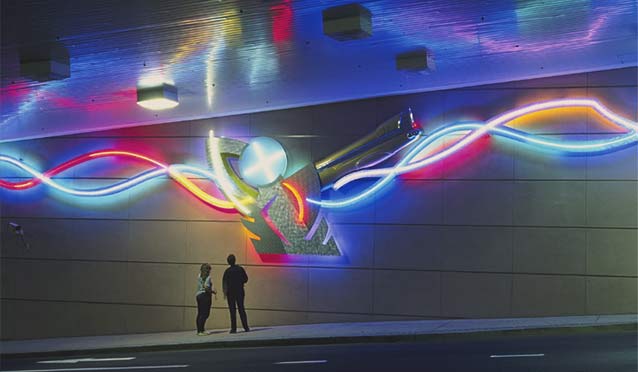L.A.
Angel is not only art, it is also Los Angeles. Its title, its
imagery, and its materials speak of the city’s past and present, as
well as its culture, industry and character. The center of L.A.
Angel has a stylized, abstract human shape, constructed of lightweight
honeycomb aluminum sheets used in the aircraft industry and accented with
streaks of neon lights. The head of the figure is an enlarged version of a
Fresnel glass lens, which is used by the motion picture industry for lighting
sets during filming. Multiple colored neon streamers flowing out from both
sides of the body resonate because of the history of neon signage in Los Angeles.
Neon lighting was invented in Europe, but the first commercial sign in the
United States was installed in Los Angeles by Earl C. Anthony for his Packard
distributorship in 1922. The juxtaposition of neon and automobiles, the role
automobiles play in shaping the city, and the symbolic relationship between
the automobile and Los Angeles is displayed by the angel’s wing made
from a 1957 Plymouth “Fury” rear quarter panel.
Lakich wanted a quarter panel from a
1957 Plymouth Fury because she felt it was the “most angelic looking
rear panel” on cars made during the 1950s and that the decorative trim
looked like gold lamé. It was also relatively flat, making it easy
to work with. However, she had difficulty finding one because they rusted
and disintegrated due to poor drainage. After spending two years checking
trade publications and visiting junk yards, Lakich was ready to substitute
a panel from a Cadillac.1 The 1992 civil disturbance
following the Rodney King verdict made her more determined than ever to use
one from a “Fury” because the name was expressive of the rage
that engulfed the city. She finally located a panel in Phoenix through a trade
publication, brought it to Los Angeles, and had it restored and painted.
L.A. Angel,
the largest work Lili Lakich had executed at the time, is a unique piece of
public art because it was commissioned to solve a specific practical problem.
The extension of California Plaza on Bunker Hill created a tunnel-like effect
along a section of Olive Street. In order to meet the City’s lighting
standards,2 Metropolitan Structures, the developer of
California Plaza, decided to install a light sculpture and asked the Museum
of Neon Art in 1989 to recommend women artists for a $75,000 commission. Lakich,
one of three artists considered for the project, presented three basic concepts,
each in two different sizes: 1) Angel’s Flight; 2) Phantom
Angel and 3) L.A. Angel. Angel’s Flight had three
variations: Pegasus, a central abstract figure and long spreading
streamers; Icarus, a central figure constructed of machine parts; and a combination
of Pegasus and Icarus—Angel’s Flight.
Phantom Angel incorporated a more representational figure than the
ones in Angel's Flight. The architect of the office towers at California
Plaza, Arthur Erickson, decided to install the larger version of L.A. Angel.3
After the work was installed in 1992,
Metropolitan Structures threatened to withhold Lakich’s final payment
unless she gave them her copyrights and other ownership rights granted under
Federal and State laws.4 With approximately 100 works of public art completed
in downtown under the Community Redevelopment Agency’s public art policies,
this was the only time a developer ever demanded the right to alter, reproduce,
remove and demolish a work at their discretion. But this was not the only
time Metropolitan Structures acted in a high-handed manner. The year before,
they not only constructed part of California Plaza with material that was
not approved by the Cultural Affairs Commission, they assumed a “take
it or leave it” attitude when the Commission objected to their action.5
Metropolitan Structure’s threat to cut off Lakich’s funds came
at a particularly vulnerable time because she had to pay the installers of
L.A. Angel. Nevertheless, she refused to sign her rights away and
attempted to resolve the matter through her attorney. When that failed, she
sought help from the Community Redevelopment Agency. After the Agency informed
Metropolitan Structures of their opposition to their demand, the developer
backed off and quickly made the final payment.
—
By Michael Several
Footnotes:
1 Angel Art: Lakich Neon Flies on the Wall at Cal Plaza, By Stacy Kravetz,
Downtown
News, March 1, 1993, p. 18.
2 Minutes of Cultural Affairs Commissioners, October 133, 1988, November 10,
1988.
3 Interview of Lili Lakich by Michael Several, September 22, 1999.
4 Letter from Jill S. Smith, Administrative Assistant, to Lili Lakich, re:
Transfer of Licenses
and Rights, June 25, 1992.
5 Letter from David H. Simon, President, Board of Cultural Affairs Commission,
to Mr
Nyal Leslie, President, Metropolitan Structures West, Inc., June 26, 1991.


